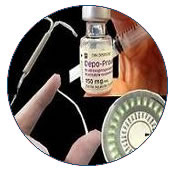Progestin-only
Hormonal Contraception Linked to Lower HDL Levels and More
Insulin Resistance in Women with HIV
 |
 |
 |
 |
 |
 |
 |
| SUMMARY:
HIV positive women
who use progestin-only hormonal contraception
(such as injections, implants, or the "mini-pill")
are more likely to have low levels of high-density
lipoprotein and greater insulin resistance than
women who use combined estrogen/progestin methods.
These findings, published in the December
2009 Journal of Acquired Immune Deficiency
Syndromes, suggest that combination contraceptive
methods may be preferable for women at risk for
cardiovascular disease. |
|
 |
 |
 |
 |
 |
 |
 |
By
Liz Highleyman
 Given
that both HIV and hormonal
contraceptives have been linked to metabolic
abnormalities, Julie Womack from Yale University School
of Nursing and colleagues investigated the link between
progestin-only and estrogen/progestin combination contraceptive
methods and disorders of glucose
and lipid metabolism.
Given
that both HIV and hormonal
contraceptives have been linked to metabolic
abnormalities, Julie Womack from Yale University School
of Nursing and colleagues investigated the link between
progestin-only and estrogen/progestin combination contraceptive
methods and disorders of glucose
and lipid metabolism.
The study included 885 HIV positive and 408 HIV negative
women from the Women's Interagency HIV Study (WIHS) seen
between October 2000 and September 2005.
The investigators used linear mixed models to evaluate the
association between hormonal contraception and metabolic
parameters including fasting high-density lipoprotein (HDL
or "good cholesterol"), low-density lipoprotein
(LDL or "bad cholesterol"), triglycerides, blood
glucose, and insulin resistance using the HOMA-IR method.
Results
 |
Compared
with no hormonal contraception, progestin-only methods
were independently associated with lower HDL levels,
a risk factor for cardiovascular disease: |
| |
 |
-3
mg/dL for HIV positive women; |
 |
-6
mg/dL for HIV negative women. |
|
 |
Progestin-only
contraception was also independently associated with
greater insulin resistance (higher HOMA-IR scores): |
| |
 |
+0.86
for HIV positive women; |
 |
+0.56
for HIV negative women. |
|
 |
In
contrast, combined estrogen/progestin contraception
was associated with higher HDL levels, which is protective
against cardiovascular disease: |
| |
 |
+5
mg/dL for HIV positive women; |
 |
+5
mg/dL for HIV negative women. |
|
Based on these findings, the study authors concluded, "HIV-infected
women using progestin-only hormonal contraception have lower
HDL and greater HOMA-IR than HIV-infected non-hormonal contraception
users."
"Combined hormonal contraception may be preferred in
HIV-infected women of reproductive age at risk for cardiovascular
disease, but interactions with antiretroviral therapy that
may impair contraceptive efficacy have been reported,"
they continued. "Alternative hormonal contraception
methods that minimize adverse outcomes but maintain efficacy
require further study."
Yale University School of Nursing, New Haven, CT.
1/1910
Reference
JA
Womack, R Scherzer, SR Cole, and others. Hormonal Contraception
and Metabolic Outcomes in Women With or at Risk for HIV
Infection. Journal of Acquired Immune Deficiency Syndromes
52(5): 581-587 (Abstract).
December 2009.
